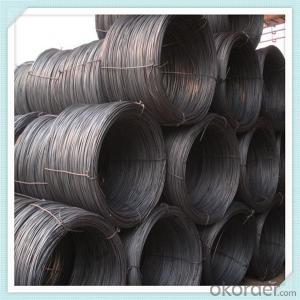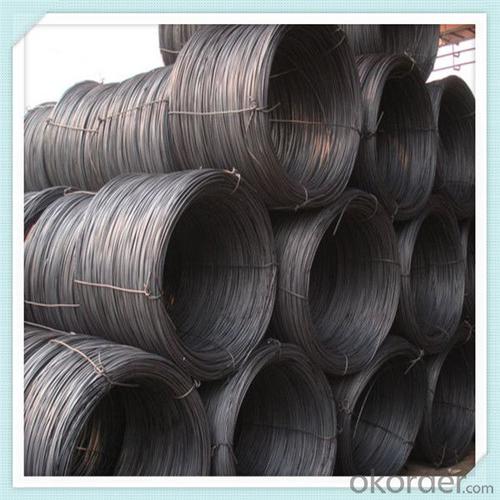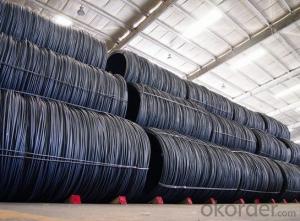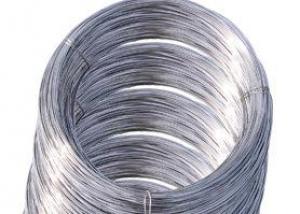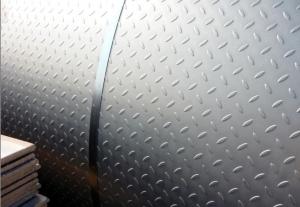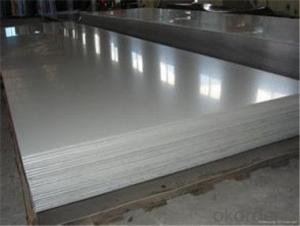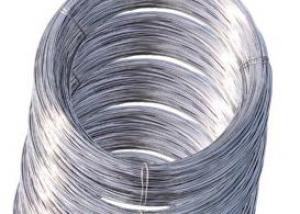Q235 Steel wire rod hot rolled from china
- Loading Port:
- Dalian
- Payment Terms:
- TT OR LC
- Min Order Qty:
- 1000 m.t.
- Supply Capability:
- 17531 m.t./month
OKorder Service Pledge
OKorder Financial Service
You Might Also Like
Specification
Steel wire is mainly used for prestressed and posttensioning technology in various shapes of prestressed
concrete structures,and widely used for civil engineering construction, such as large scale railroad, highway
bridges, building trusses, overhead crane beams, industrial and prefabricated concrete floor, wall board,
tubular piles, PC water pipes, TV towers and nuclear power station, ETC. Active strandards:GB/T5223,
ASTMA421, BS5896, JISG3536, ISO6934, EN10138 or other special required standards.
Features
1、Pure steel quality, stable chemical contents, small tolerance.
2、Constant Quality, good drawing performance.
3、High dimension accuracy degree, accuracy degree of Level C up to 80%, smooth surface, less scale,
easy to be pickled.
4、Automatic bundling with 4 lines by Machine in tidy and good looks
5、Big high quality percentage, small coil percentage, and heavy coil weight for Hard Coil.
6、High sorbitizing percentage.
Product Description :
Standard | AISI, ASTM, BS, DIN, GB, JIS |
Material/steel grade | Q195-Q235,SAE1006B,SAE1006CR, SAE1008B, SAE1008CR, SAE1010B, SAE1018B, or according to customers requirements |
Wire Gauge | 5.5-12mm |
Coil weight | 1.8-2.1mts |
MOQ | 25MT |
Delivery Time | 15-30 days after receipt of L/C or deposit by T/T |
Packing | In coil and load in container, if large quantity, by bulk vessel; Can be packed as customers' special requirements |
Payment terms | 1).100% irrevocable L/C at sight. 2).30% T/T prepaid and the balance against the copy of B/L. 3).30% T/T prepaid and the balance against L/C |
Application | widely used in machinery parts, manufacturing industry, electronics industry, metal tools and others |
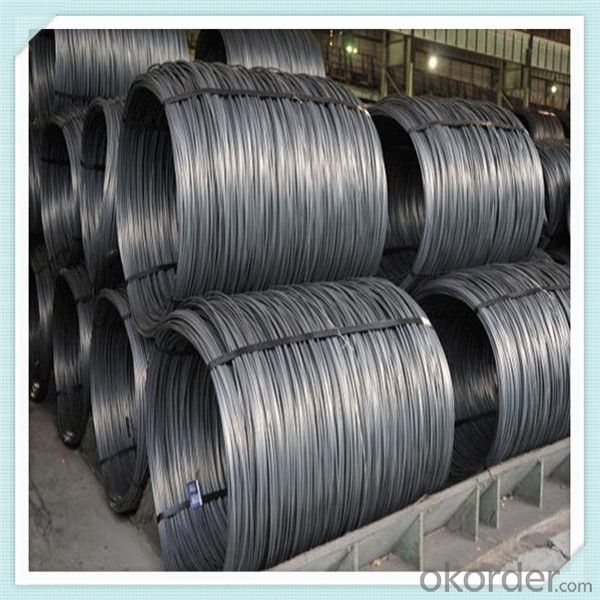
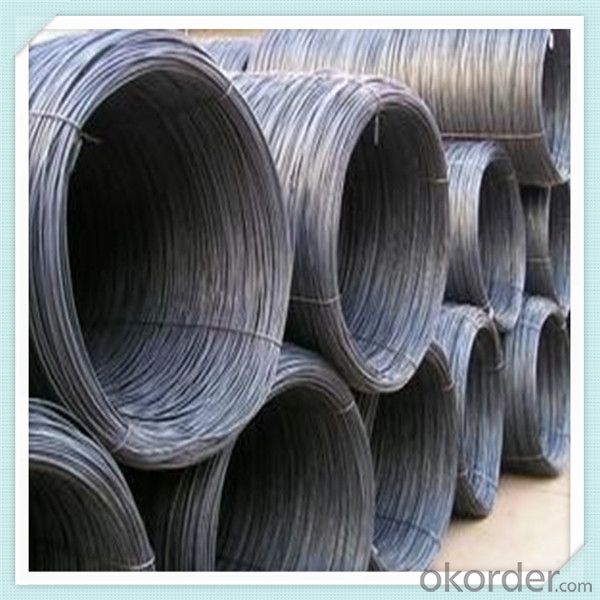
Application :
It generally used in braiding the hose for bathing product and machinery. With it
good flexibility, resistant to high temperature and resistant to corrosion, it
used widely in many industries.
Packing :
Hot-rolled wire rod is held in a unit with at least four steel straps in the
transverse direction and transported and stored without further packaging.
Before
the steel strapping is applied, the wire rod must be sufficiently compressed.
The strapping is fixed in the transverse direction with a single circumferential
strap so that the strapping does not slip and cause the coil to come apart.
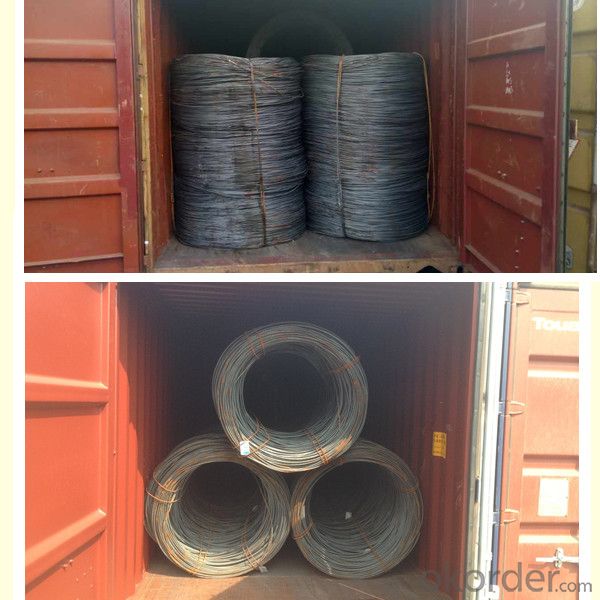
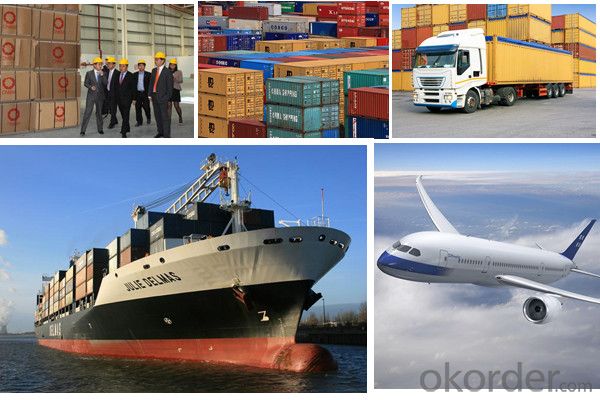
Our service:
(1) We cooperate with famous factories with advanced equipment and well trained workers.
(2) We can provide factory price with trading company service.
(3) We continuously work on the improvement of our processes, guaranteeing
consistently high standards of quality to keep none compensation.
(4) We guarantee 24 hours response and 48 hours solution providing service.
(5) We accept small order quantity before formal cooperation.
(6) We deliver the agreed quality at the agreed time, reacting to changes in
customer wishes in a flexible way.
(7) Due to our volume and selling power, we have excellent freight rates with
shipping lines.
(8) We strive to always be fair and honest in our dealings with customers.
(9) We strive to work together with customers to achieve much more than we can
achieve alone.
(10) Through our passion and commitment we aim to be a market leader in all our
key markets. To maintain our position as market leader we must continue to add
value in all that we do.
FAQ:
1.Q: What's your MOQ(minimum order quantity)?
A: One full container, mixed acceptable .
2. Q: What's your packing methods?
A: Packed in bundle or bulk ..
3. Q: How can I buy CNBM products in my country?
A:Please send us an inquiry or email ,we will reply to you if there is distributor in your country
4. Q: Can we visit your factory?
A: Warmly welcome. Once we have your schedule, we will arrange the
professional sales team to follow up your case.
5. Q: How long does it take to get the product if i place an order?
A:With the process of your requirements,we will pack and deliver in 3
-7 days. If it is by sea shipment,it will take 15-45 days depending on different locations
- Q: How is steel wire rod used in the manufacturing of wire forms for jewelry?
- Steel wire rod is an essential material used in the manufacturing of wire forms for jewelry. It is primarily utilized to create intricate and delicate wire shapes and structures that are commonly found in various types of jewelry, such as earrings, necklaces, bracelets, and rings. The steel wire rod is initially processed through a series of steps to transform it into a malleable and workable material. First, it is drawn through a die to reduce its diameter and achieve the desired thickness. This process, known as wire drawing, ensures that the steel wire rod becomes thin and pliable enough to be molded into intricate shapes. Once the wire rod has been drawn, it can be further manipulated and formed into various wire forms for jewelry. Skilled artisans use specialized tools, such as pliers, hammers, and mandrels, to bend, twist, and shape the wire into different designs. These wire forms can be as simple as loops or spirals, or they can be more complex and intricate, depending on the desired jewelry design. The steel wire rod's strength and durability make it an ideal material for creating wire forms that can withstand regular wear and tear. It provides the necessary support for gemstones, beads, and other decorative elements that may be added to the jewelry piece. Additionally, the steel wire rod's resistance to corrosion ensures that the wire forms remain intact and retain their shape over time. Furthermore, steel wire rod is often used as a base material for plating with precious metals such as gold or silver. The wire forms are coated with a thin layer of the desired metal, enhancing their aesthetic appeal and giving them a luxurious finish. This plating process adds value to the jewelry piece and makes it more visually appealing to customers. In summary, steel wire rod plays a crucial role in the manufacturing of wire forms for jewelry. Its malleability, strength, and resistance to corrosion make it an ideal material for creating intricate and durable wire shapes. Whether used as a base material or plated with precious metals, steel wire rod allows artisans to craft stunning and unique jewelry pieces that are both aesthetically pleasing and long-lasting.
- Q: What are the common inspection methods for steel wire rod?
- The common inspection methods for steel wire rod include visual inspection, dimensional measurement, chemical composition analysis, mechanical testing, and surface quality evaluation.
- Q: What are the different decarburization testing methods for steel wire rod?
- There are several decarburization testing methods that are commonly used for steel wire rod. These methods are designed to determine the depth and extent of decarburization in the steel wire rod. 1. Macro examination: This method involves visually inspecting the surface of the steel wire rod for signs of decarburization. The rod is cut and polished, and then examined under a microscope to determine the depth and severity of decarburization. 2. Micro examination: Similar to macro examination, micro examination involves examining the surface of the steel wire rod under a microscope. However, this method provides a more detailed and magnified view of the decarburization. Micro examination allows for a more accurate measurement of the depth and extent of decarburization. 3. Chemical analysis: Chemical analysis involves taking a sample of the steel wire rod and analyzing its composition. This method can be used to determine the carbon content of the steel and compare it to the desired specifications. A higher carbon content indicates a lower level of decarburization. 4. Hardness testing: Decarburization can affect the hardness of the steel wire rod. Hardness testing involves measuring the resistance of the rod to indentation or penetration. A decrease in hardness can indicate the presence of decarburization. 5. Microhardness testing: Similar to hardness testing, microhardness testing involves measuring the hardness of the steel wire rod. However, this method uses a smaller and more precise indenter, allowing for a more accurate measurement of the hardness and the presence of decarburization. 6. Metallographic analysis: Metallographic analysis involves preparing a sample of the steel wire rod, polishing it, and then examining it under a microscope. This method allows for the observation of the microstructure of the steel and the presence of decarburization. These decarburization testing methods are essential in ensuring the quality and integrity of the steel wire rod. By using a combination of these methods, manufacturers can accurately assess the level of decarburization and take appropriate measures to maintain the desired quality standards.
- Q: What are the different surface defects that can impact the weldability of steel wire rod?
- There are several surface defects that can impact the weldability of steel wire rod. Some common ones include mill scale, rust, oil, and dirt. Mill scale refers to the thin layer of iron oxide that forms on the surface of the steel during the manufacturing process. Rust is another surface defect that occurs when the steel is exposed to moisture, leading to the formation of iron oxide. Oil and dirt can also negatively impact weldability by creating a barrier between the steel and the welding electrode, resulting in poor fusion and weak welds.
- Q: What are the main factors influencing the choice of steel wire rod buyer?
- The choice of steel wire rod buyer can be influenced by various factors, depending on the specific needs and requirements of the buyer. However, there are several common factors that significantly impact the decision-making process. Firstly, buyers place utmost importance on the quality of steel wire rods. They carefully assess factors such as composition, strength, and durability. Furthermore, buyers evaluate the supplier's quality control measures, certifications, and track record to ensure that they receive high-quality products that meet their specifications. Secondly, pricing plays a crucial role for buyers as it directly affects their overall costs. Buyers compare prices from different suppliers to find the most competitive offer without compromising on quality. Negotiations may occur to reach a mutually beneficial agreement. Thirdly, buyers prefer suppliers who demonstrate reliability by consistently meeting their demands and delivering products on time. Reliability in terms of product availability, timely delivery, and consistent performance is crucial for buyers to ensure smooth operations and avoid disruptions in their supply chain. Furthermore, steel wire rod buyers often require technical support from their suppliers. They seek assistance in selecting the appropriate grade and size of wire rods for their specific applications. Additionally, buyers value suppliers who provide technical data and specifications and offer expertise in troubleshooting or addressing any concerns that may arise during usage. In addition, the reputation and trustworthiness of potential suppliers are important considerations for buyers. They may request references, reviews, and feedback from other customers to evaluate the supplier's track record and reliability. A good reputation can instill confidence in buyers and influence their decision. Moreover, buyers appreciate suppliers who offer excellent after-sales service. This includes providing assistance with any issues or concerns that arise after the purchase, offering warranty or guarantee programs, and providing ongoing support to ensure customer satisfaction. Lastly, with the increasing emphasis on sustainability, buyers are becoming more mindful of the environmental impact of their purchases. They may prefer suppliers who employ sustainable and environmentally friendly practices, such as using recycled materials or implementing energy-efficient production processes. In conclusion, the choice of steel wire rod buyer is influenced by factors such as quality, price, reliability, technical support, reputation, after-sales service, and sustainability considerations. By considering these factors, buyers can make informed decisions that not only meet their immediate needs but also align with their long-term goals and values.
- Q: What are the different types of steel wire rod surface finishes after wire drawing?
- Wire drawing can result in various surface finishes for steel wire rods. These finishes serve multiple purposes, such as improving wire performance, safeguarding it from corrosion, and protecting it from environmental factors. Here are some commonly used surface finishes for steel wire rods: 1. Bright finish: After wire drawing, the wire retains its natural state, resulting in a shiny, reflective surface. This finish is suitable for applications where aesthetics are not a primary concern. 2. Galvanized finish: To prevent corrosion, the wire is coated with a layer of zinc. Galvanized wire has a matte appearance and is commonly utilized in outdoor settings exposed to moisture and harsh conditions. 3. Phosphated finish: Through a chemical process called phosphating, the wire receives a phosphate coating that enhances its corrosion resistance and adhesion properties. This finish is ideal for applications involving high temperatures or corrosive environments. 4. Coated finish: A protective layer of polymer or another material is applied to the wire's surface. Coated wire possesses a smooth, uniform appearance and is often used when insulation or abrasion protection is necessary. 5. Nickel-plated finish: The wire undergoes a process where it is coated with a layer of nickel. This finish enhances corrosion resistance and improves the wire's appearance, resulting in a bright, shiny surface. Nickel-plated wire is frequently employed in decorative applications or environments exposed to moisture and corrosive substances. These examples demonstrate the variety of steel wire rod surface finishes obtainable after wire drawing. The selection of a specific finish depends on the application's requirements and the desired properties of the wire.
- Q: What are the main factors affecting the market advertising of steel wire rod?
- The main factors affecting the market advertising of steel wire rod include the demand and consumption patterns of industries that utilize steel wire rod, the overall economic conditions and growth rate of the construction and manufacturing sectors, the competitive landscape and pricing strategies of steel wire rod manufacturers, technological advancements and product innovation in the industry, government regulations and policies related to steel production and trade, and the effectiveness of marketing and advertising campaigns in reaching and influencing the target audience.
- Q: How is the chemical composition of steel wire rod analyzed?
- The chemical composition of steel wire rod is typically analyzed using various techniques and methods. One common method is called spectroscopy, which involves the use of instruments such as atomic absorption spectroscopy (AAS) or inductively coupled plasma spectroscopy (ICP). These instruments can accurately determine the presence and concentration of different elements in the steel wire rod. Another technique commonly used is X-ray fluorescence (XRF), which works by bombarding the sample with X-rays and measuring the energy emitted by the elements present in the steel wire rod. This method provides quick and non-destructive analysis of the chemical composition. In addition to spectroscopy and XRF, other methods like optical emission spectroscopy (OES) and mass spectrometry can also be employed for analyzing the chemical composition of steel wire rod. These techniques involve the vaporization and ionization of the sample, followed by the measurement of the resulting ions or emitted photons. It is important to note that these techniques require the steel wire rod to be prepared as a sample, often in the form of a solid or liquid. The sample is usually dissolved, digested, or mixed with appropriate reagents to extract the elements of interest before analysis. Overall, the analysis of the chemical composition of steel wire rod is a crucial step in quality control and ensuring that the material meets the required specifications for its intended use.
- Q: What are the different applications of stainless steel wire rod?
- Stainless steel wire rods have numerous applications across various industries. They are commonly used in the manufacturing of springs, cables, wire mesh, welding electrodes, fasteners, and reinforcing materials in construction. Additionally, stainless steel wire rods find use in the automotive industry for making exhaust systems, automotive springs, and brake cables. They are also utilized in the production of kitchen appliances, medical equipment, and electrical components due to their corrosion resistance, strength, and durability.
- Q: What are the common testing methods for steel wire rod?
- Common testing methods for steel wire rod include tensile testing, hardness testing, ultrasonic testing, and dimensional testing.
Send your message to us
Q235 Steel wire rod hot rolled from china
- Loading Port:
- Dalian
- Payment Terms:
- TT OR LC
- Min Order Qty:
- 1000 m.t.
- Supply Capability:
- 17531 m.t./month
OKorder Service Pledge
OKorder Financial Service
Similar products
Hot products
Hot Searches
Related keywords
